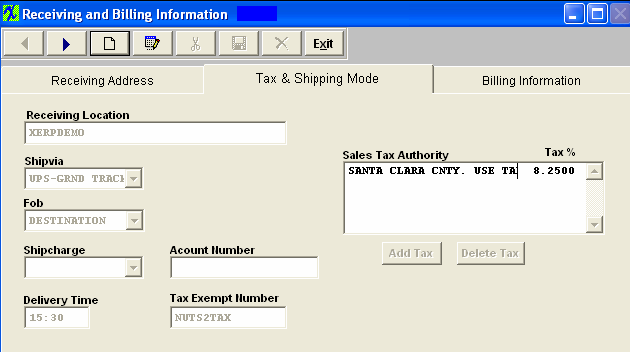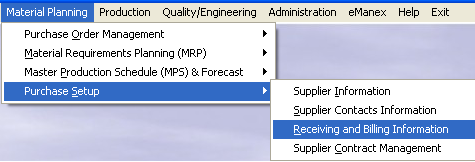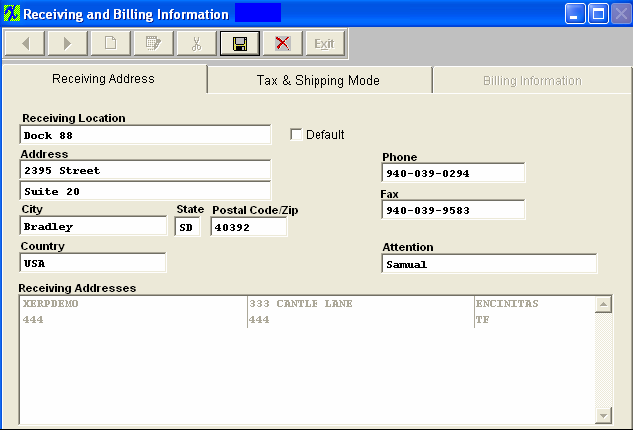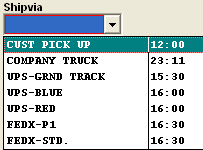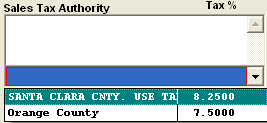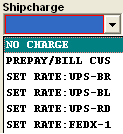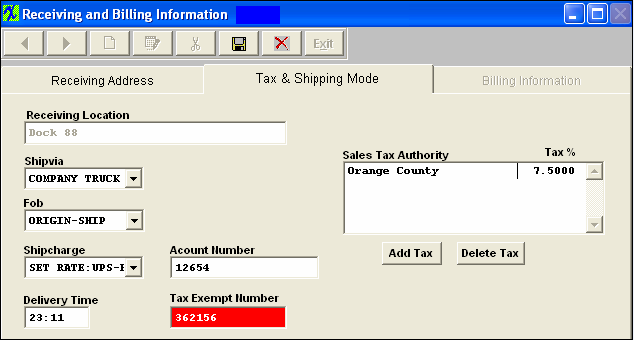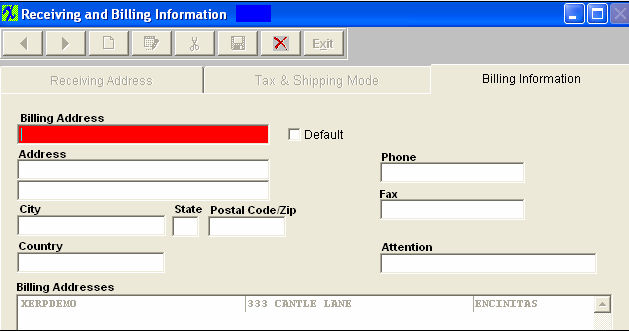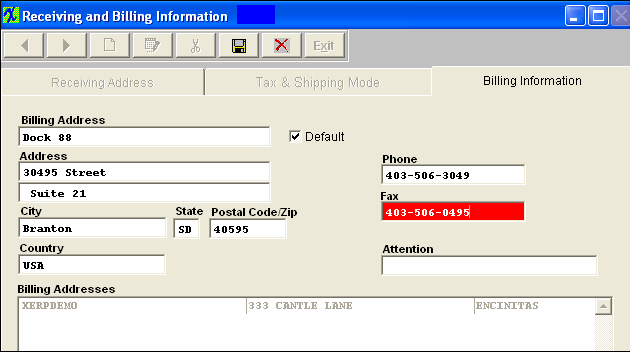| 1. Receiving And Billing Information |
| 1.1. Prerequisites for Receiving & Billing Information | ||||||||
Prerequisites for Entering Receiving & Billing Information:
After activation, "Receiving Information" access for each user must be setup in the ManEx System Security module. Users with “Supervisor Rights” will automatically have access.
The Sales Tax Authority must be setup in System Setup /Sales Tax Authority Table The Ship Via must be set up in System Setup /Ship Via The FOB must be setup in System Setup /FOB The Ship Charge must be setup in System Setup /Ship Charge
|
| 1.2. Introduction for Receiving & Billing Information |
| The Receiving & Billing Information Module is used to record the details of the user’s billing and receiving addresses. |
| 1.3. Fields & Definitions for Receiving & Billing Information |
| 1.3.1. Receiving Address Tab | ||||||||||||||||||||||
|
| 1.3.2. Tax & Shipping Mode Tab | ||||||||||||||||
|
| 1.3.3. Billing Information Tab | ||||||||||||||||||||||
|
| 1.4. How To ..... for Receiving & Billing Information |
| 1.4.1. Add Receiving and Billing Information | ||||||||||
|
The following screen will appear:
Depress the Add action Button. Type in all of the receiving information that you want to appear in your Purchase Order. Type in the user’ s information as follows: The company name of the user’s receiving location. This is a required field. If you have more than one receiving location, you must select at least one as the default. You can choose among the selection of receiving addresses when you prepare the purchase order. Type in the street address where you want your goods delivered. Two address lines are allowed. The second line is for a suite number, etc. Type in the phone number at the receiving location. Type in the fax number at the receiving location. Type in the city, state and zip code. Type in the country of the receiving location. Type in the name of the contact at the receiving location. A sample of the completed screen appears below:
Depress the Tax and Shipping Mode information. This screen has information for carrier name, FOB, tax status, etc. The name of the company at the receiving location carries over from the previous screen and can’t be edited.
Type in the name of the carrier. Refer to System Setup procedures for Ship Via to set up this information. Depress the down arrow and the following screen will appear: Select the name of the carrier.
This selection is for Free-on-board information. This is the point when title passes. Refer to System Setup procedures for FOB section to set up this information. Depress the down arrow and the following screen will appear: Select the appropriate FOB point. Sales Tax
The sales tax authority and the Tax % is for those purchases which are subject to tax. Refer to System Setup procedures for Sales Tax Authority Table section to set up this information. Depress the Add Tax button and the sales tax authority selections will appear: Choose the one applicable to your company’s purchases. This selection is for Shipcharge selection. This will indicate the shipcharge preference of the user. Refer to System Setup procedures for Ship Charge to set up this information. Depress the down arrow and the following screen will appear: Select the appropriate Ship charge. Type in the user’s account number in those instances where the user will be paying the freight charges directly to the carrier and not to the supplier. Type in the time when the delivery is expected to be at the receiving location. Type in the user’s sales tax identification number for those purchases which are not subject to sales tax. Please check with your state or local sales tax authorities for more information regarding Sales Tax exemptions since the laws vary from state to state. A sample of the completed screen appears below:
Depress the Save record action button to save changes, or depress the Abandon changes action button to abandon changes. Depress the Billing information tab. This would be the address of the user’s Accounts Payable department. Depressing the tab and depressing the Add record button, will bring up the following screen:
Type in the name of the user. This is a required field. If you have more than one billing location, you must select at least one as the default. You can choose among the selection of billing addresses when you prepare the purchase order. Type in the street address where you want your billing mailed. Two address lines are allowed. The second line is for a suite number, etc. Type in the phone number at the billing location. Type in the fax number at the billing location. Type in the city, state and zip code. Type in the country of the billing location. Type in th name of the contact at the billing location, normally Accounts Payable, for example. The completed screen would appear as follows:
Depress the Save record action button to save changes, or depress the Abandon changes action button to abandon changes. Depress the Exit action button and return to the previous screen |


